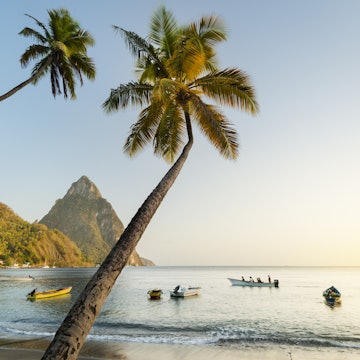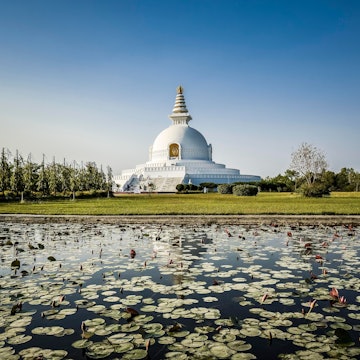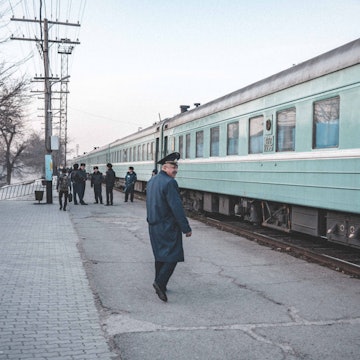

Asia offers gorgeous beaches, delicious food and vistas to choose from, like Man Thai beach in Da Nang, Vietnam. XUAN THONG/Shutterstock
As the world’s largest continent, summers vary vastly in Asia. You have, on one end, sun-kissed isles, where exploring in flip-flops is a delicate breeze. On the other end, high humidity and torrential rains keep everyone strictly in the confines of air-conditioned malls.
Venturing north may appear to be the best option for travelers. However, the region isn’t foolproof to Mother Nature. In Tokyo, for example, August's heat and humidity are exacerbated by the densely built and populated city. Likewise, the southeast’s microclimates mean select islands can be a tropical haven, particularly Indonesia’s archipelagos, when summer is their sweet spot for blue sunny skies. Of course, such optimum conditions in the peak of high season equate to soaring demand, and you’ll need to plan far ahead.
To help, we’ve rounded up the best places in Asia to visit during the summer months of June, July and August.
June

1. Busan, South Korea
Best city for K-culture
Seoul may be the mecca for Korean entertainment, but international visitors can still get a slice of the action in Busan. The country's second-largest city brims with K-drama shooting locations, K-Pop dance troupes and K-beauty stores just like its northern counterpart, but it’s far less crowded, and the prices are kinder on the wallet. June falls off full-bloom cherry blossom season, and summer hasn’t quite reached its full momentum yet. Even if climate change plays tricks, a slew of beaches like Haeundae offer respite. Otherwise, expect to enjoy the rainbow wonders of Gamcheon Culture Village and fresh catch at Jagalchi Fish Market in comfy 72 °F conditions.
Planning tip: Busan was formerly a popular jumping-off point for tourists hoping to tick off Japan, thanks to a 3.5-hour high-speed ferry to Fukuoka. Since that ferry’s permanent closure in December 2024, you’ll now need to take a 55-minute flight or stomach an 11.5-hour ferry crossing instead.

2. Da Nang, Vietnam
Best region for beach hopping
Vietnam experiences heavy downpours throughout the summer, but thankfully that’s not the case along the northern coastline. Da Nang is an outdoor lovers' paradise, whether you choose to frolic on idyllic beaches like My Khe and Non Nuoc or explore the unique architecture of sites like Dragon Bridge. The coastal city has a rich Cham history, which can be discovered in the Museum of Cham Sculpture. Modern amenities at bargain prices make Da Nang one of the most livable Southeast Asian spots, so expect your Vietnamese Dong to stretch far, even in peak season. Da Nang is also within an hour’s drive of UNESCO site Hoi An.
Planning tip: Summers in Vietnam call for copious helpings of Chè, a traditional sweet beverage, dessert soup or pudding that’s served cold and usually with ice for a refreshing finish. Vietnamese iced coffees are also a firm favorite.

3. Singapore
Best city for diverse eats
Though Singapore’s tropical climate is constant all year round, June is a good time to visit due to the lower (by Singaporean standards) humidity. Summer rain is much less frequent than the rest of the year. The island nation is home to four key ethnic groups: Malay, Chinese, Indian and Indonesian. You can sample their specialties (and more) quite affordably at hawker centers, open-air community dining halls. Newton Hawker Center is one of the most recognizable, as it was used in the movie Crazy Rich Asians. Speaking of which, hawkers aside, the rest of the little red dot will appear steep in comparison to its Southeast Asian neighbors. Double your daily budget, and explore city greats such as the futuristic Gardens by the Bay and the upscale Orchard Road.
Planning tip: It may be up to 88°F outside, but shopping malls and even taxi cabs blast AC. Bring a light sweater for your dip in and out of a cold blast.
July

4. Shimla, India
Best city for walking
India may not spring to mind when it comes to cooling off, but the domestic secret is Shimla. The city in the northernmost state of Himachal Pradesh was once the retreat of the 19th-century British colonial government. In an attempt to escape harsh summers, they went to the foothills of the Himalayas, turning Shimla into a British hill station packed with amenities. Now, Indians come to comfortably enjoy Tudorbethan and neo-Gothic architecture in 81 to 88°F heat. Walking’s a breeze thanks to pedestrian-only zones. Don’t miss the Harry Potter-esque Viceregal Lodge and the Rothney Castle, and watch out for snack-pinching Rhesus monkeys.
Planning tip: Lengthy photo shoots are a big part of Indian vacation culture, so expect to dodge selfie sticks and tripods during your trip. Some are not used to foreigners, and it’s common for tourists to receive meet-and-greet requests akin to that of a rock star. If you’re okay with this, keep an eye on time as a line may form.

5. Bali, Indonesia
Best region for picturesque corners
There’s no better time to knock out the Bali bucket list than July. It’s relatively dry and pleasantly warm (75°F to 88°F), which means everything is oh-so-beautiful, just like you’ve seen on Instagram. Everyone else has lush Ubud jungles and white sand beaches on their agenda, too, so if you can’t beat them, join them. There are tours to bash out the obligatory snaps in one single day. After that, retreat to a villa or luxury resort for a Balinese massage, or hit up a beach club and try an Arak cocktail. Bali’s packed year-round, but coming at the very start of July might at least help filter out families waiting for the school holidays to commence.
Planning tip: If you’re not a local, be very careful with washed salads and even ice cubes. Google ‘Bali Belly,’ and you’ll see why. Bring meds, and book any important tours at the beginning of your trip in case you must reschedule.

6. Almaty, Kazakhstan
Best city for affordable outdoor experiences
July is the peak season to visit Almaty, but as a relatively under-the-radar Asian tourist destination, that means things come alive rather than get overcrowded. The weather hovers between 57 and 81°F, ideal for exploring the local museums and cathedrals or enjoying the city’s nightlife. However, with easy access to natural landscapes, you’ll want to bask in those delightful temperatures outdoors. Popular day trips include Big Almaty Lake and the Trans-Ili Alatau mountains, both just over an hour’s drive from town.
Planning tip: Local delicacies include Kazy (horse meat sausage), Beshbarmak (boiled meat and flat noodles) and Shubat (fermented camel’s milk), but don’t worry if you don’t want to spend the whole trip being adventurous. Almaty has plenty of familiar Chinese, Korean and Turkish dishes.
August

7. Sendai, Japan
Best alternative to the famous cities
There’s so much more to Japan than Kyoto, Tokyo and Osaka, and while the tourists stampede on that holy trinity, consider Sendai (aka ‘City of Trees’) to breathe. You have here everything you came to Japan for: fresh sushi, wacky karaoke and ancient temples, but you get to experience them like a local in this young, student-heavy city. Sendai may just be a 1.5-hour bullet train from Tokyo, but it’s mountains cooler. August highs are a maximum of 80°F. This is also the month of the Sendai Tanabata Festival, marked by parades, traditional performances and plenty of street food.
Planning tip: Every city or region in Japan has a signature dish, and in Sendai, it’s all about the beef tongue. Gyutan (牛タン, gyūtan) is thinly sliced beef tongue cooked over a charcoal grill.

8. Chengdu, China
Best city if you love pandas
Famed for being the home of giant pandas, those visiting Chengdu in late August are likely to see cubs at their cutest. They’re actually born blind and hairless, weighing just 100g, and it’s not until a month later that their distinct markings fluff on in. You can view them at the Giant Panda Breeding Research Base. Average August temperatures are now 77°F, however, this month is typically rather humid. The magnificent Jiuzhaigou National Park is an excellent place to beat the heat due to its high elevation, but if you intend on staying put in the capital of Sichuan, there are plenty of AC corners in this sprawling megacity of 21 million inhabitants.
Planning tip: Many schools start to reopen in the last week of August, so sticking to the end of the month means a fizzle down in crowds (as well as fluffier baby pandas!).

9. Altai Mountains, Mongolia
Best region for going off the grid
With over 14 hours of daylight in August, you can take your time in the Altai Mountains of Mongolia. The area has a wealth of archaeological sites, including the ruins of the ancient city of Kharakhot. There are also snow-capped mountains to hike or climb and verdant valleys that teem with native maral deer and argali sheep. You may decide to camp at Khoton Lake or join a homestay at a traditional village for a peek into local nomadic culture. Wi-fi is either limited or nonexistent here, so all you can do is surrender to the back-to-basics way of living and blissfully disconnect from the modern.
Planning tip: Altai Tavan Bogd is located in a remote part of Mongolia, and it is not the easiest place to navigate. It requires plenty of planning, and a local guide is recommended. As you’re here during the peak season, there should be plenty of operators and transportation options available.














